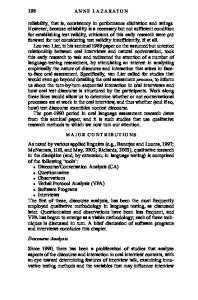Qualitative Model for Fullerene Formation +
- PDF / 420,544 Bytes
- 6 Pages / 414.72 x 648 pts Page_size
- 0 Downloads / 273 Views
TANYA YU. ASTAKHOVA, SHAGEN A.SHAGINYAN, GEORGE A.VINOGRADOV Institute of Chemical Physics, Russian Acad.Sci., Ul.Kosygina 4, Moscow 117334, Russia
ABSTRACT A new mechanism of fullerene formation is presented. The "gas-liquid" transition in the expanding flux of carbon atoms is considered as a necessary initial stage. The transition is not terminated at the liquid phase formation as the more powerful processes of network formation predominate. The process of clusters formation starts with the transformation of three-contact structures to stable two-dimensional networks and is governed by the carbon atoms specificity: three-functionality and high rate of chemical reactions. The resulting network is a flat hexagonal lattice with pentagonal "defects" bending the surface, the free energy minimum structures being fullerenes.
INTRODUCTION Fullerenes are carbon clusters C2o+2,, (n = 0, 2, 3...) with the convex closed cage polygon structures of 12 pentagons and n hexagons. As a rule, fullerenes have point symmetry groups, belonging to subgroups of icosahedral symmetry group [1]. Microscopically, fullerenes are characterized by surface density of pentagons and microexchange energy of two neighboring faces. There are two main methods of fullerenes production with a quantitative yield: one is a resistive heating or the similar arc discharge method [2]; the other is a continuous or impulse laser irradiation of carbon containing materials [3]. In both methods carbon atoms are evaporated and expanding flux of carbon atoms is formed. With arc discharge method the absolute yield and distribution function over masses depend strongly on the arc parameters (current strength, interelectrode distance). A necessary condition for a rather high fullerenes yield is the presence of a buffer gas (It is standard practice to use helium (He)). There is an extreme dependence of the yield on helium pressure with maximum at -100 Torr. Pressure variation causes changes in a relative distribution over isomers yield [4]. Apparently, strong electric and magnetic fields of an arc or laser, and light irradiation influence on the fullerenes yield.
+ this work is partially supported by ISTC under grant # 079 193 Mat. Res. Soc. Symp. Proc. Vol. 359 e 19 9 5 Materials Research Society
Thus, the necessary experimental conditions of fullerenes formation are: 1) high initial temperature and pressure of carbon vapour; 2) a presence of a buffer gas - one atomic gas with high ionization potential; 3) fast expansion of carbon vapour into the buffer gas. The thermalization rate at the expense of the buffer gas is treated to be rather high to maintain a quasi-equilibrium state of the system. Structures observed in mass-spectra were investigated using the ion drift mobility technique [5]. It was supposed that at the early stage of the evolution monocyclic polyyne clusters are formed. Joining, they form bi- and multycycles. When the number of atoms in a cluster achieves -40, then a spheroidal structure (and fullerenes finally) is possible. Still, the microscopic
Data Loading...










